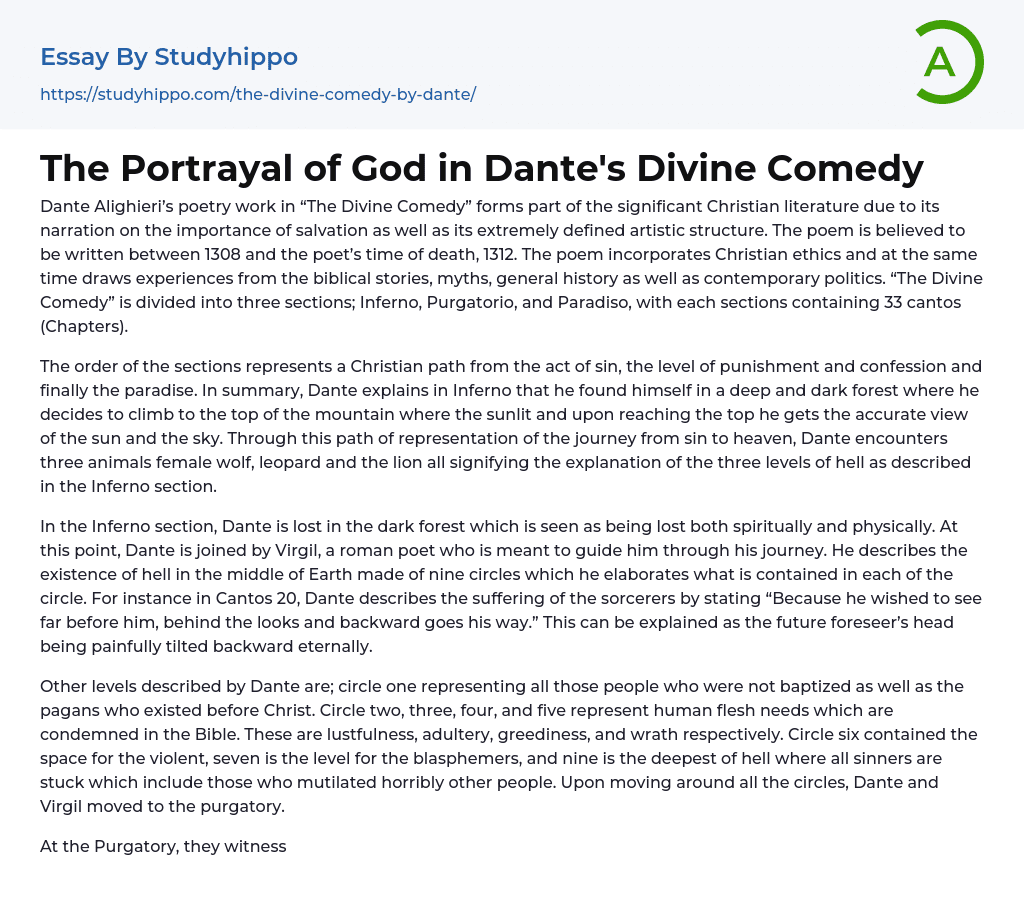

The Portrayal of God in Dante’s Divine Comedy Essay Example
Dante Alighieri’s poetry work in “The Divine Comedy” forms part of the significant Christian literature due to its narration on the importance of salvation as well as its extremely defined artistic structure. The poem is believed to be written between 1308 and the poet’s time of death, 1312. The poem incorporates Christian ethics and at the same time draws experiences from the biblical stories, myths, general history as well as contemporary politics. “The Divine Comedy” is divided into three sections; Inferno, Purgatorio, and Paradiso, with each sections containing 33 cantos (Chapters).
The order of the sections represents a Christian path from the act of sin, the level of punishment and confession and finally the paradise. In summary, Dante explains in Inferno that he found himself in a deep
...and dark forest where he decides to climb to the top of the mountain where the sunlit and upon reaching the top he gets the accurate view of the sun and the sky. Through this path of representation of the journey from sin to heaven, Dante encounters three animals female wolf, leopard and the lion all signifying the explanation of the three levels of hell as described in the Inferno section.
In the Inferno section, Dante is lost in the dark forest which is seen as being lost both spiritually and physically. At this point, Dante is joined by Virgil, a roman poet who is meant to guide him through his journey. He describes the existence of hell in the middle of Earth made of nine circles which he elaborates what is contained in each of the circle. For instance in Cantos 20, Dante describes the suffering of th
sorcerers by stating “Because he wished to see far before him, behind the looks and backward goes his way.” This can be explained as the future foreseer’s head being painfully tilted backward eternally.
Other levels described by Dante are; circle one representing all those people who were not baptized as well as the pagans who existed before Christ. Circle two, three, four, and five represent human flesh needs which are condemned in the Bible. These are lustfulness, adultery, greediness, and wrath respectively. Circle six contained the space for the violent, seven is the level for the blasphemers, and nine is the deepest of hell where all sinners are stuck which include those who mutilated horribly other people. Upon moving around all the circles, Dante and Virgil moved to the purgatory.
At the Purgatory, they witnessed the sinful souls undergoing punishment for the sins they committed for the purposes of cleansing themselves to get ready for heaven. The mood at this section has changed in that all the souls will be headed to heaven clean while those who did not confess remains in hell for eternal torture. Purgatory in a mountain shaped image consists of seven levels representing the human sins, and the souls move freely around the levels praising God amidst their punishment as they are being cleansed. At this point, Virgil does not continue to heaven, but Dante is joined by another guide - Beatrice.
In heaven, Dante describes it as a divine place comprising nine spheres representing the orbits. The joyful songs of praise and delight mark the heaven. Souls entering heaven basks in the glory of the Lord eternally. At this point, Dante and Beatrice
meet other Christian figures and Dante is taught more of God’s nature.
The general view of Dante is that there is life ahead for every human after death but according to Judaism, what is important is the current life and not after death. Still the Sadducees points out that there is no biblical evidence of the afterlife. My opinion is that Dante purposed to explain to the audience the importance of salvation through describing the suffering and eventually the reward at the end.
- Afterlife essays
- Atheism essays
- Bible essays
- Buddhism essays
- Christian Worldview essays
- Christianity essays
- Confession essays
- Cosmological Argument essays
- Deism essays
- Devil essays
- Existence of God essays
- Faith essays
- Freedom Of Religion essays
- God essays
- Hinduism essays
- Immortality essays
- Islam essays
- Jainism essays
- Jews essays
- Judaism essays
- Miracle essays
- Monk essays
- Monotheism essays
- New Testament essays
- Old Testament essays
- Pilgrimage essays
- Puritans essays
- Revelation essays
- Ritual essays
- Salvation essays
- Sin essays
- Sinners essays
- Soul essays
- Taoism essays
- Temple essays
- Theology essays
- Allegory essays
- Alliteration essays
- Comedy essays
- Comic book essays
- Drama essays
- Dystopia essays
- Fairy Tale essays
- Fantasy essays
- Fiction essays
- Ghost essays
- Gothic Fiction essays
- Gothic Literature essays
- Irony essays
- Legend essays



